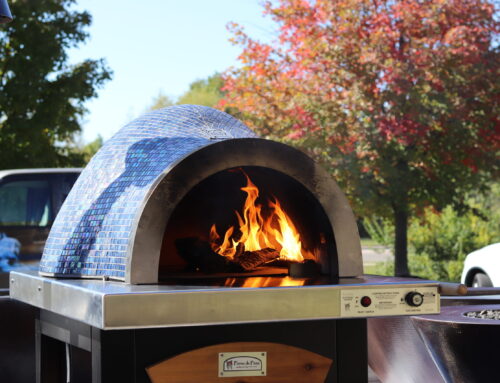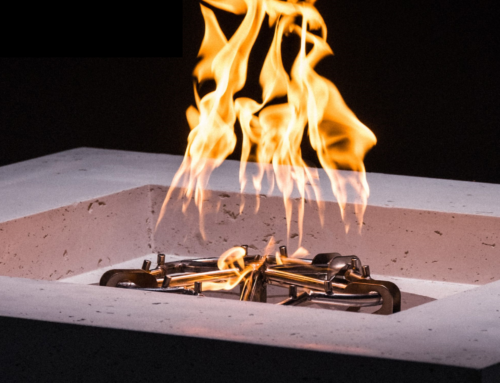
To maximize the longevity and ensure peak performance of your appliance, it is imperative to make a few maintenance steps a priority. HPC Fire Inspired has got your back. Beyond creating beautiful and functional fire features, HPC believes in the importance of educating consumers. Here are HPC’s top five essential maintenance tips to ensure your fire pit appliance operates safely and efficiently throughout the season.
- Inspect the Gas Supply Lines
HPC recommends conferring with a certified gas professional to check the gas supply lines 1-2 times per year to ensure every component is operating optimally. The first step in preparing your fire feature for the spring season is to check the gas supply lines for any signs of wear or damage. Freezing temperatures and harsh winter weather can cause cracks or leaks in the hoses and fittings. Carefully inspect these areas for any signs of wear and tear. Replace any damaged parts before turning on your fire feature to avoid any safety hazards. Pro tip, when inspecting gas lines, it’s always a good idea to use a soapy water solution to check for leaks. If bubbles form when applied to joints and connections, this indicates there is a leak. Working with gas professionals ensures that gas supply is in tact.
- Clean Media
Start by removing media from the pan. Next, clean the media with mild soapy water. Doing so will remove any build up that has accumulated over the time of use. Before returning the media to the pan, be sure to allow it to dry properly. While the media is drying, it is the perfect opportunity check the burner.
- Check Burner and Pilot Assembly
Over time, debris such as dirt, leaves, and even insects can clog the burner and the pilot assembly. Cleaning these components ensures smooth ignition and a clean, consistent flame. In addition, while the media is out check the burner for cracks. If there is damage to the burner, simply follow up with HPC and they will send a new burner as part of HPC’s lifetime guarantee. Next, inspect the pilot assembly and thermocouple for damage. If these components are damaged simply contact HPC to obtain new parts to be installed.
Check out this video for ways to resolve common issues with pilot assemblies:
- Clean the Surrounding Area
While this step may seem basic, cleaning the area around your fire feature is essential to maintaining safety and appearance. Ensure there are no flammable materials like leaves, paper, or outdoor furniture too close to the fire pit. Sweep away any dirt, dust, or debris that may have accumulated around the fire feature over the winter. Make sure that all ventilation openings are
free of any debris. Regular cleaning helps maintain the beauty of your fire feature while preventing any potential safety hazards.
- Check The Breaker, GFI & Plug
Once your fire feature is reassembled, it’s time to check the breaker and GFI is turned on. Be sure the gas supply is in the off position. Turn the circuit breaker on to apply power to the unit to verify that the igniter is working. For detailed breakdown based on ignition style check out the chart below:
ELECTRONIC IGNITION UNITS (ON/OFF & HI/LO):
- Perform a visual inspection of burner and pilot assembly. This may involve removing the media. Ensure there are no cracks in the burner and the pilot assembly (igniter/hood/thermocouple) are in good shape and have no signs of damage
- Ensure ventilation openings on the enclosure are not covered with leaves and debris
- Turn the circuit breaker on and apply power to the unit (gas line should still be closed) to verify that igniter is working properly. The igniter should glow even with the gas turned off
- Return the media to the pan. Now would be a good time give the media a cleaning in warm mild soapy water
- Reconnect the unit to the gas line and open the service valve on the gas line
- Apply power and fire up the fire pit or fire feature, this may take a few cycles to bleed gas line
PUSH BUTTON FLAME SENSING (FPPK):
- Remove media and perform a visual inspection of burner and pilot assembly. Ensure there are no cracks in burner and pilot assembly is not visibly damaged
- Install battery into spark module and push the igniter button in to ensure the igniter has good spark
- Inspect the enclosure ventilation openings and clear them of debris
- Turn the gas line on and fire up the fire pit or fire feature this may take a few cycles to bleed the gas line
MATCH-LIT (MLFPK):
- Remove media and inspect burner for cracks and clean debris from the pan
- Inspect ventilation openings and ensure they clear of leaves and debris
- Turn gas line on and fire up the fire pit or fire feature
Conclusion
Spring is the ideal time to give your HPC Fire Inspired fire feature a little attention and care. By following these simple maintenance tips, you’ll ensure that your HPC Fire design is ready for use all season long. From inspecting the gas lines to cleaning the burner and pilot assembly, a little maintenance goes a long way in keeping your fire feature safe and beautiful. Have questions? Reach out to our certified gas experts to help provide guidance around all your fire pit needs.




